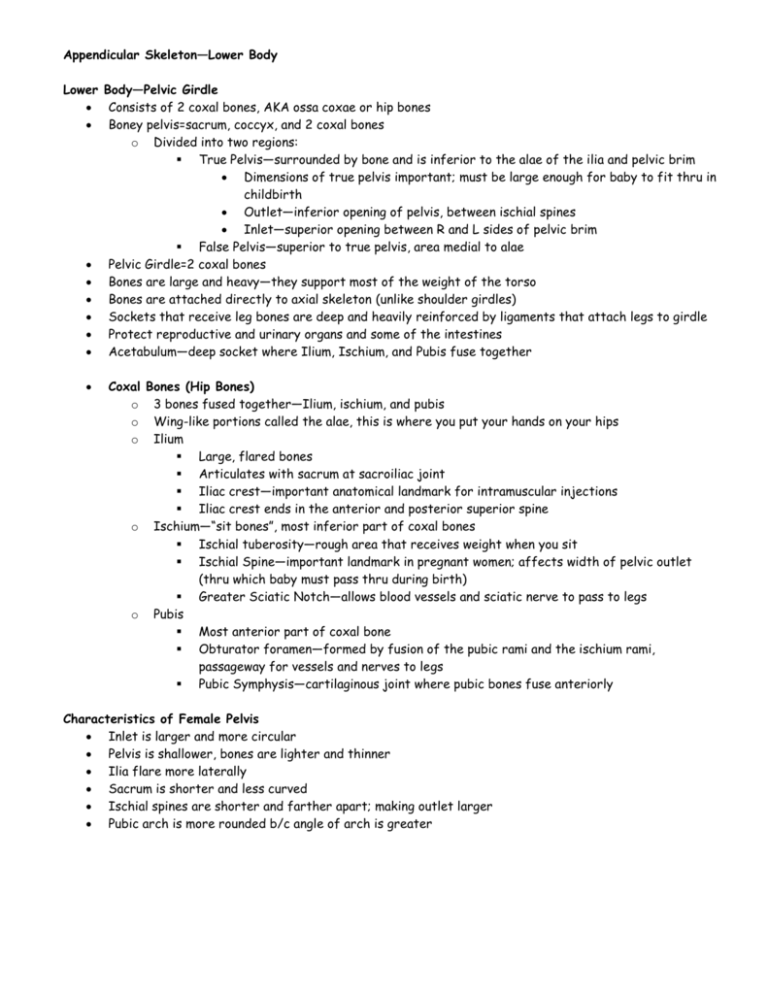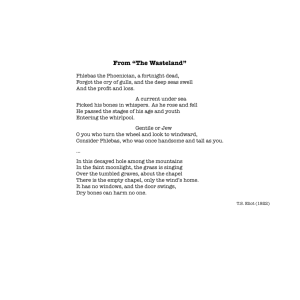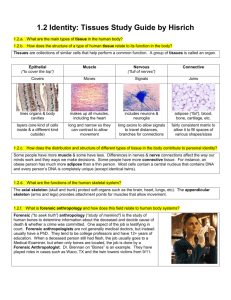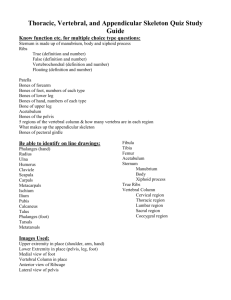Appendicular Skeleton—Lower Body
advertisement

Appendicular Skeleton—Lower Body Lower Body—Pelvic Girdle Consists of 2 coxal bones, AKA ossa coxae or hip bones Boney pelvis=sacrum, coccyx, and 2 coxal bones o Divided into two regions: True Pelvis—surrounded by bone and is inferior to the alae of the ilia and pelvic brim Dimensions of true pelvis important; must be large enough for baby to fit thru in childbirth Outlet—inferior opening of pelvis, between ischial spines Inlet—superior opening between R and L sides of pelvic brim False Pelvis—superior to true pelvis, area medial to alae Pelvic Girdle=2 coxal bones Bones are large and heavy—they support most of the weight of the torso Bones are attached directly to axial skeleton (unlike shoulder girdles) Sockets that receive leg bones are deep and heavily reinforced by ligaments that attach legs to girdle Protect reproductive and urinary organs and some of the intestines Acetabulum—deep socket where Ilium, Ischium, and Pubis fuse together Coxal Bones (Hip Bones) o 3 bones fused together—Ilium, ischium, and pubis o Wing-like portions called the alae, this is where you put your hands on your hips o Ilium Large, flared bones Articulates with sacrum at sacroiliac joint Iliac crest—important anatomical landmark for intramuscular injections Iliac crest ends in the anterior and posterior superior spine o Ischium—“sit bones”, most inferior part of coxal bones Ischial tuberosity—rough area that receives weight when you sit Ischial Spine—important landmark in pregnant women; affects width of pelvic outlet (thru which baby must pass thru during birth) Greater Sciatic Notch—allows blood vessels and sciatic nerve to pass to legs o Pubis Most anterior part of coxal bone Obturator foramen—formed by fusion of the pubic rami and the ischium rami, passageway for vessels and nerves to legs Pubic Symphysis—cartilaginous joint where pubic bones fuse anteriorly Characteristics of Female Pelvis Inlet is larger and more circular Pelvis is shallower, bones are lighter and thinner Ilia flare more laterally Sacrum is shorter and less curved Ischial spines are shorter and farther apart; making outlet larger Pubic arch is more rounded b/c angle of arch is greater Lower Body—Limbs Carry total body weight when body is upright Consist of thigh, leg, foot Thigh o o o (femur bone) Longest, heaviest, strongest bone in body Slants medially to bring knees in line with body’s center of gravity’; more obvious in females Proximal Features Head—articulates with hip bone at acetabulum in deep socket Neck of femur is common site of femur fractures Greater, lesser trocanters and gluteal tuberosity—sites of muscle attachment Intertrochanter line (anterior) and Intertrochanteric crest (posterior) separate greater and lesser trochanters o Distal Features Lateral and medial condyles (posterior)—articulate with tibia Intercondylar fossa—separates lat and med condyles Patellar surface (anterior) forms joint with patella Leg o o o o Foot o o o o o o Two bones—tibia (larger, medial) and fibula (lateral) Connected by interosseous membrane Tibia Proximal Features Lateral and Medial condyles form joint with distal end of femur to form knee joint Intercondylar eminence separate lat and med condyles Tibial Tuberosity—attaches to patellar ligament Distal Features Medial Malleolus—inner bulge of ankle Anterior border—sharp ridge on anterior surface of tibia, not protected by muscles, easily palpable Fibula Thin, stick-like Not part of knee joint Lateral Malleous—at distal end, forms outer part of ankle Tarsals, metatarsals, phalanges Support weight and act as lever to move body forward when walking/running Bones arranged to form three arches—two longitudinal and one transverse Ligaments and tendons hold bones in place to maintain arches, but allow flexibility Tarsus (tarsals) Posterior part of foot 7 bones Body weight is carried by two largest tarsals—calcaneus (heel bone) and talus (between tibia and calcaneus) Metatarsals 5 bones Form sole of foot Phalanges 14 in each foot 3 in each toe (like hand), 2 in big (great) toe








